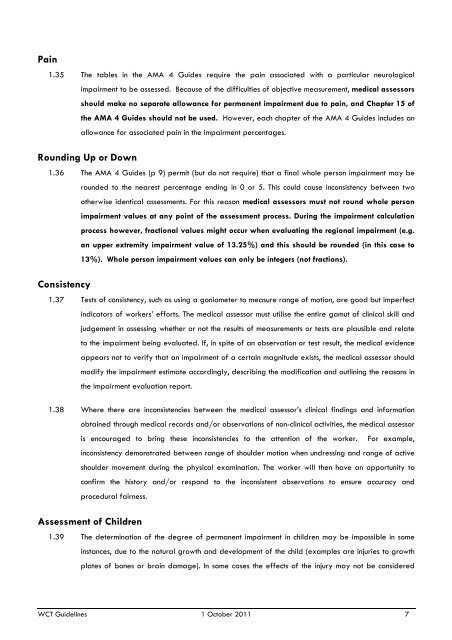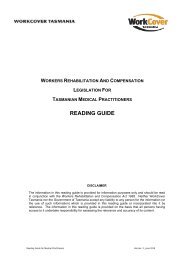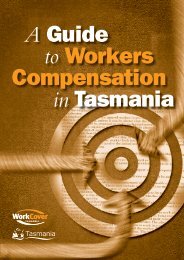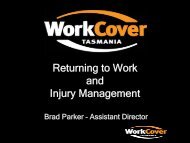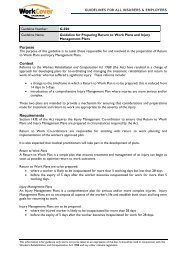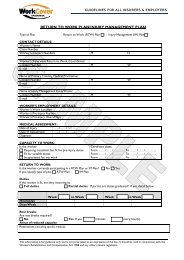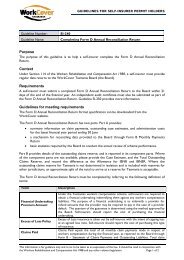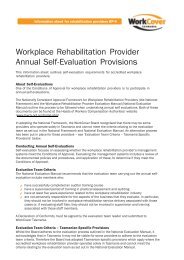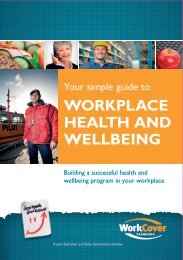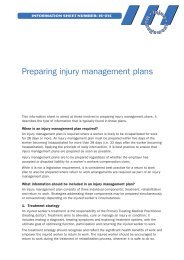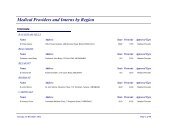Guidelines for the assessment of permanent impairment Version 3
Guidelines for the assessment of permanent impairment Version 3
Guidelines for the assessment of permanent impairment Version 3
You also want an ePaper? Increase the reach of your titles
YUMPU automatically turns print PDFs into web optimized ePapers that Google loves.
Pain1.35 The tables in <strong>the</strong> AMA 4 Guides require <strong>the</strong> pain associated with a particular neurological<strong>impairment</strong> to be assessed. Because <strong>of</strong> <strong>the</strong> difficulties <strong>of</strong> objective measurement, medical assessorsshould make no separate allowance <strong>for</strong> <strong>permanent</strong> <strong>impairment</strong> due to pain, and Chapter 15 <strong>of</strong><strong>the</strong> AMA 4 Guides should not be used. However, each chapter <strong>of</strong> <strong>the</strong> AMA 4 Guides includes anallowance <strong>for</strong> associated pain in <strong>the</strong> <strong>impairment</strong> percentages.Rounding Up or Down1.36 The AMA 4 Guides (p 9) permit (but do not require) that a final whole person <strong>impairment</strong> may berounded to <strong>the</strong> nearest percentage ending in 0 or 5. This could cause inconsistency between twoo<strong>the</strong>rwise identical <strong>assessment</strong>s. For this reason medical assessors must not round whole person<strong>impairment</strong> values at any point <strong>of</strong> <strong>the</strong> <strong>assessment</strong> process. During <strong>the</strong> <strong>impairment</strong> calculationprocess however, fractional values might occur when evaluating <strong>the</strong> regional <strong>impairment</strong> (e.g.an upper extremity <strong>impairment</strong> value <strong>of</strong> 13.25%) and this should be rounded (in this case to13%). Whole person <strong>impairment</strong> values can only be integers (not fractions).Consistency1.37 Tests <strong>of</strong> consistency, such as using a goniometer to measure range <strong>of</strong> motion, are good but imperfectindicators <strong>of</strong> workers’ ef<strong>for</strong>ts. The medical assessor must utilise <strong>the</strong> entire gamut <strong>of</strong> clinical skill andjudgement in assessing whe<strong>the</strong>r or not <strong>the</strong> results <strong>of</strong> measurements or tests are plausible and relateto <strong>the</strong> <strong>impairment</strong> being evaluated. If, in spite <strong>of</strong> an observation or test result, <strong>the</strong> medical evidenceappears not to verify that an <strong>impairment</strong> <strong>of</strong> a certain magnitude exists, <strong>the</strong> medical assessor shouldmodify <strong>the</strong> <strong>impairment</strong> estimate accordingly, describing <strong>the</strong> modification and outlining <strong>the</strong> reasons in<strong>the</strong> <strong>impairment</strong> evaluation report.1.38 Where <strong>the</strong>re are inconsistencies between <strong>the</strong> medical assessor’s clinical findings and in<strong>for</strong>mationobtained through medical records and/or observations <strong>of</strong> non-clinical activities, <strong>the</strong> medical assessoris encouraged to bring <strong>the</strong>se inconsistencies to <strong>the</strong> attention <strong>of</strong> <strong>the</strong> worker. For example,inconsistency demonstrated between range <strong>of</strong> shoulder motion when undressing and range <strong>of</strong> activeshoulder movement during <strong>the</strong> physical examination. The worker will <strong>the</strong>n have an opportunity toconfirm <strong>the</strong> history and/or respond to <strong>the</strong> inconsistent observations to ensure accuracy andprocedural fairness.Assessment <strong>of</strong> Children1.39 The determination <strong>of</strong> <strong>the</strong> degree <strong>of</strong> <strong>permanent</strong> <strong>impairment</strong> in children may be impossible in someinstances, due to <strong>the</strong> natural growth and development <strong>of</strong> <strong>the</strong> child (examples are injuries to growthplates <strong>of</strong> bones or brain damage). In some cases <strong>the</strong> effects <strong>of</strong> <strong>the</strong> injury may not be consideredWCT <strong>Guidelines</strong> 1 October 2011 7


